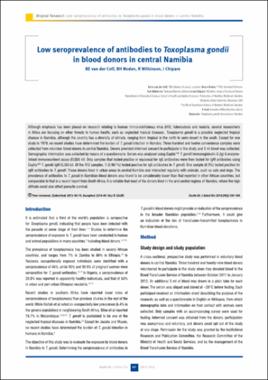| dc.contributor.author | van der Colf, Berta | |
| dc.contributor.author | Noden, Bruce | |
| dc.contributor.author | Wilkinson, Rob | |
| dc.contributor.author | Chipare, Israel | |
| dc.date.accessioned | 2022-04-12T13:53:22Z | |
| dc.date.available | 2022-04-12T13:53:22Z | |
| dc.date.issued | 2014 | |
| dc.identifier | oksd_noden_lowseroprevalence_2014 | |
| dc.identifier.citation | van der Colf, B. E., Noden, B. H., Wilkinson, R., & Chipare, I. (2014). Low seroprevalence of antibodies to Toxoplasma gondii in blood donors in central Namibia. Southern African Journal of Infectious Diseases, 29(3), pp. 101-104. https://doi.org/10.1080/23120053.2014.11441579 | |
| dc.identifier.uri | https://hdl.handle.net/11244/335192 | |
| dc.description.abstract | Although emphasis has been placed on research relating to human immunodeficiency virus (HIV), tuberculosis and malaria, several researchers in Africa are focusing on other threats to human health, such as neglected tropical diseases. Toxoplasma gondii is a possible neglected tropical disease in Namibia, although the country has a diversity of climate, ranging from tropical in the north to semi-desert in the south. Except for one study in 1978, no recent studies have determined the burden of T. gondii infection in Namibia. Three hundred and twelve convenience samples were collected from volunteer blood donors in central Namibia. Donors provided informed consent to participate in the study, and 5 ml blood was collected. Demographic information was collected by means of a questionnaire. Serum was analysed using Captia^TM T. gondii immunoglobulin G (Ig) G enzymelinked immunosorbent assay (ELISA) kit. Only samples that tested positive or equivocal for IgG antibodies were then tested for IgM antibodies using Captia^TM T. gondii IgM ELISA kit. Of the 312 samples, 3 (0.961%) tested positive for IgG antibodies to T. gondii. One sample (0.3%) tested positive for IgM antibodies to T. gondii. These donors lived in urban areas in central Namibia and interacted regularly with animals, such as cats and dogs. The prevalence of antibodies to T. gondii in Namibian blood donors was found to be considerably lower than that reported in other African countries, but comparable to that in a recent report from South Africa. It is notable that most of the donors lived in the arid central regions of Namibia, where the high altitude could also affect parasite survival. | |
| dc.format | application/pdf | |
| dc.language | en_US | |
| dc.publisher | Informa UK Limited | |
| dc.relation.ispartof | Southern African Journal of Infectious Diseases, 29 (3) | |
| dc.rights | This material has been previously published. In the Oklahoma State University Library's institutional repository this version is made available through the open access principles and the terms of agreement/consent between the author(s) and the publisher. The permission policy on the use, reproduction or distribution of the material falls under fair use for educational, scholarship, and research purposes. Contact Digital Resources and Discovery Services at lib-dls@okstate.edu or 405-744-9161 for further information. | |
| dc.title | Low seroprevalence of antibodies to Toxoplasma gondii in blood donors in central Namibia | |
| dc.date.updated | 2022-04-07T14:31:29Z | |
| osu.filename | oksd_noden_lowseroprevalence_2014.pdf | |
| dc.description.peerreview | Peer reviewed | |
| dc.identifier.doi | 10.1080/23120053.2014.11441579 | |
| dc.description.department | Entomology and Plant Pathology | |
| dc.type.genre | Article | |
| dc.type.material | Text | |
| dc.subject.keywords | Prevention | |
| dc.subject.keywords | Emerging Infectious Diseases | |
| dc.subject.keywords | Infectious Diseases | |
| dc.subject.keywords | Vaccine Related | |
| dc.subject.keywords | Biodefense | |
| dc.subject.keywords | Rare Diseases | |
| dc.subject.keywords | 2.2 Factors relating to the physical environment | |
| dc.subject.keywords | Infection | |
| dc.subject.keywords | 3 Good Health and Well Being | |
| dc.identifier.author | ORCID: 0000-0002-0096-370X (Noden, BH) | |
| dc.identifier.author | ScopusID: 6601968347 (Noden, BH) | |
